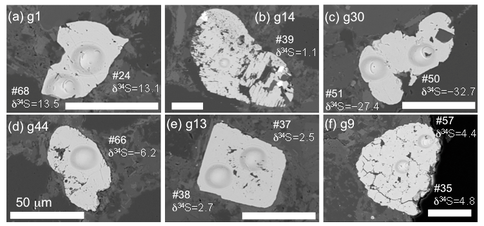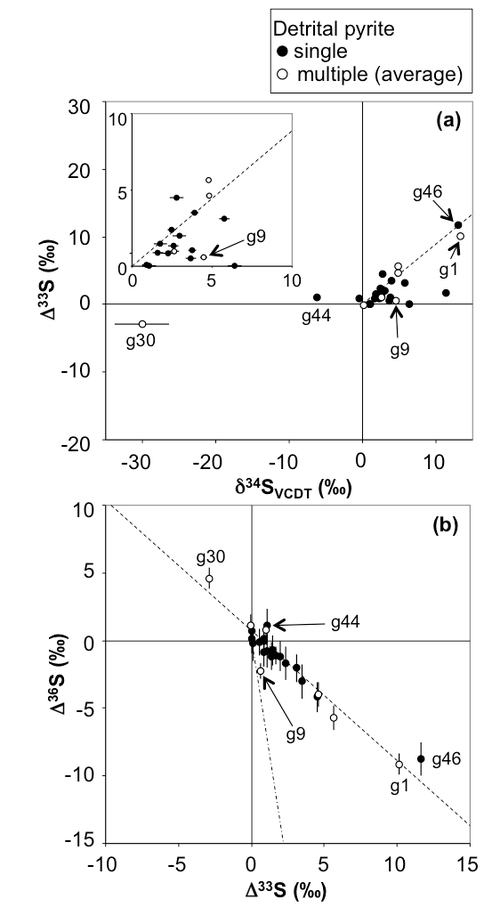2014 Annual Science Report
 University of Wisconsin
Reporting | SEP 2013 – DEC 2014
University of Wisconsin
Reporting | SEP 2013 – DEC 2014
Project 4B: New SIMS Procedures for in Situ Analysis of Mass-Independent Fractionation of S Isotopes
Project Summary
An in situ sulfur four-isotope analysis technique with multiple Faraday cup detectors by ion microprobe was developed and applied to detrital pyrite grains in ~2.4 Ga glaciogenic sandstone from the Meteorite Bore Member of the Turee Creek Group, Western Australia.
Project Progress
An in situ sulfur four-isotope analysis technique with multiple Faraday cup detectors by ion microprobe was developed and applied to detrital pyrite grains in ~2.4 Ga glaciogenic sandstone from the Meteorite Bore Member of the Turee Creek Group, Western Australia. Data are standardized with the UWPy-1 pyrite standard (δ34S =16.04 ± 0.18‰, Δ33S = −0.003 ± 0.009‰, and Δ36S = −0.21 ± 0.24‰, 2 SD) whose sulfur four isotopes were newly determined by gas-source mass spectrometry. Typical reproducibility at two standard deviations (2 SD) of spot-to-spot analyses of standard UWPy-1 pyrite with a primary beam size of ~20 μm were ±0.23, ±0.05, and ±0.86‰ for δ34S, Δ33S, and Δ36S, respectively. The measured 36S/32S ratio [1 / (6641 ± 27)] is approximately 19‰ lower than the published ratio for VCDT, and we propose a revision of the 36S abundance in VCDT. Pyrite grains in ~2.4 Ga glaciogenic sandstone have wide ranging sulfur isotope ratios (−32.7 to 13.5 for δ34S, −3.03 to 11.66 for Δ33S, and−9.7 to 4.6 for Δ36S, respectively). Some pyrite grains are zoned in δ34S values within a grain. Sulfur isotope ratios of most pyrite grains are distributed along a line with slope = −0.9 for Δ33S vs. Δ36S, suggesting that pyrite grains mostly derived from a limited range of source rocks and near-surface sulfur reservoirs. One pyrite aggregate has a distinct texture from other pyrite grains in the same sandstone, and yields a significant mass-independent deficit in 36S with a small excess in 33S (Δ36S/Δ33S ~−4‰). This is used to suggest that this grain authigenically formed by biological activity during or after sedimentation. This work demonstrates that the use of multiple Faraday cup detectors provides improved accuracy and precision for in situ sulfur four isotope analysis with secondary ion mass spectrometry.
Publications
-
Ushikubo, T., Williford, K. H., Farquhar, J., Johnston, D. T., Van Kranendonk, M. J., & Valley, J. W. (2014). Development of in situ sulfur four-isotope analysis with multiple Faraday cup detectors by SIMS and application to pyrite grains in a Paleoproterozoic glaciogenic sandstone. Chemical Geology, 383, 86–99. doi:10.1016/j.chemgeo.2014.06.006
-
PROJECT INVESTIGATORS:
-
PROJECT MEMBERS:
John Valley
Project Investigator
Takayuki Ushikubo
Co-Investigator
Kenneth Williford
Co-Investigator
James Farquhar
Collaborator
David Johnston
Collaborator
Noriko Kita
Collaborator
Reinhard Kozdon
Collaborator
Martin Van Kranendonk
Collaborator
-
RELATED OBJECTIVES:
Objective 4.1
Earth's early biosphere.
Objective 7.1
Biosignatures to be sought in Solar System materials
Objective 7.2
Biosignatures to be sought in nearby planetary systems

